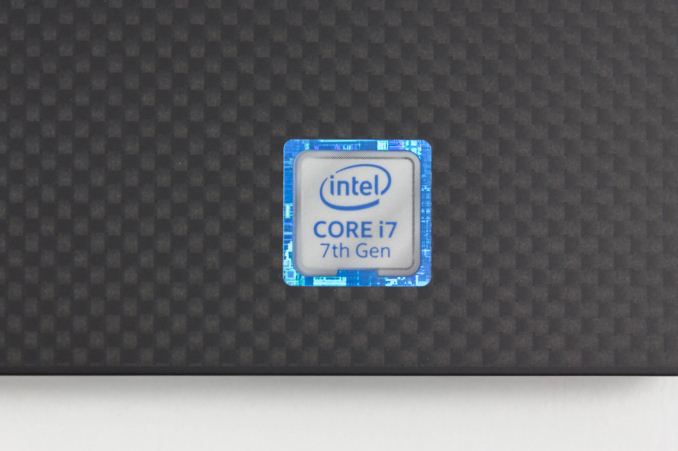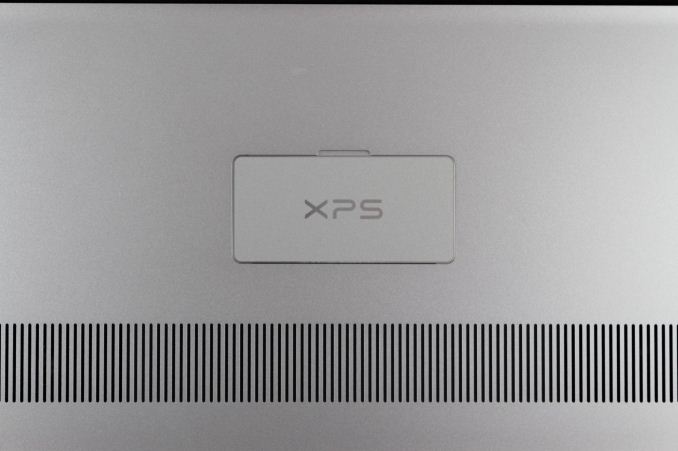The Dell XPS 15 9560 Review: Infinity Edge Part Two
by Brett Howse on July 31, 2017 8:00 AM EST
Near the end of 2015, Dell rolled out their new XPS styling cues, that were so successful on the XPS 13, to its larger sibling, the XPS 15. Thanks to the Infinity Edge display, Dell’s new XPS 15 packed a full 15.6-inch display into a notebook closer to the size of a 14-inch model. Perhaps the size reduction is not quite as dramatic as the XPS 13 when it first launched with the thin-bezel design, but Dell also kept the performance heart of the XPS 15 intact with the change, keeping a quad-core 45-Watt CPU, and NVIDIA GTX 960M graphics.
Dell has since done a revision from that XPS 15 9550 model to the latest 9560 version. The small model number change might signify that this is a small revision. On the exterior that is certainly the case, with the overall XPS 15 design remaining relatively unchanged, but under the hood there are some more impressive changes awaiting.
The first is a move to Intel’s 7th generation Core processors. Although performance per clock did not change from 6th to 7th generation, a new, improved, 14nm process does allow higher frequencies without blowing through the thermal design power restraints. This allows a small boost in performance over the same designation CPU from the previous design.
More importantly, NVIDIA announced newer graphics to replace the outgoing Maxwell based GTX 960M. The Pascal based GTX 1050 is a significant upgrade, dropping the M branding. Pascal offers much more compute, thanks to the new architecture based on 14nm FinFET, and the GDDR5 capacity doubles from the 2 GB on the GTX 960M to 4 GB on the GTX 1050. The XPS 15 was never a gaming laptop, but a much more capable graphics card certainly helps propel it closer to those dedicated machines, and also can play a big role in compute tasks that can leverage the GPU.
| Dell XPS 15 9560 Configurations | |||
| Core i3 | Core i5 | Core i7 (Model Tested) |
|
| GPU | Intel HD 630 | Intel HD 630 + NVIDIA GeForce GTX 1050 w/4GB GDDR5 |
|
| CPU | Intel Core i3-7100H (35w) Dual-Core w/HyperThreading 3.0 GHz |
Intel Core i5-7300HQ (45w) Quad-Core 2.5-3.5 GHz |
Intel Core i7-7700HQ (45w) Quad-Core w/HyperThreading 2.8-3.8 GHz |
| Memory | 8-32GB DDR4-2400 RAM Two SODIMM slots, 32GB Max |
||
| Display | 15.6" IPS 1920x1080 sRGB | 15.6" IPS 1920x1080 sRGB Optional 3840x2160 IGZO IPS w/Adobe RGB color space and touch |
|
| Storage | 500GB 7200 RPM Hybrid w/32GB NAND | 1TB 5400 RPM Hybrid w/32GB NAND | 256/512/1024 GB PCIe NVMe SSD |
| Networking | Killer 1535 Wireless-AC 2x2 + Bluetooth 4.1 Optional Intel 8265 Wireless-AC 2x2 + Bluetooth 4.1 |
||
| I/O | USB 3.0 x 2 w/Powershare SD Card reader 1 x USB 3.1 Gen 2 Type-C w/Thunderbolt 3 (2 lanes PCIe) Headset Jack HDMI 1.4 |
||
| Dimensions | (mm) : 357 x 235 x 11-17 (inches) : 14.06 x 9.27 x 0.45-0.66 |
||
| Weight | With 56 Wh Battery 1.8 kg / 4.0 lbs With 97 Wh Battery 2 kg / 4.5 lbs |
||
| Battery | 56 Wh | 56/97 Wh | |
| Price | $999+ As tested: (Core i7-7700HQ, 3840x2160, 512 GB, 16GB) $1850 |
||
Dell didn’t stop there. The previous model offered either a 56 Wh battery, or a stout 84 Wh version. With the latest 9560 version of the XPS 15, that larger battery is bigger again, boasting a 97 Wh capacity, which is right near the 99 Wh limit allowed in a notebook. Dell claims the 9560 is the class leader in battery life for a 15.6-inch notebook, at least when doing productivity tasks, with up to 19.5 hours of battery life.
The battery life will be impacted significantly by the choice of displays though, and just like the 9550 model, Dell is offering both a 1920x1080 (FHD) non-touch version, as well as a 3840x2160 (UHD) panel with touch. The higher resolution also targets 100% of the Adobe RGB color gamut. With both a higher resolution, and wider color gamut, the UHD version is not the one to get if you need the longest battery life, but may be the optimal version if Adobe RGB is important for your workflow.
Not all of the changes are for the best though. Dell has dropped the 3x3:3 Broadcom wireless option for the 9560, which is a shame since Dell was one of the few PC suppliers to offer a 3x3:3 solution. They’ve opted to go with the same Killer Wireless-AC 1535 as they use in the smaller XPS 13. This is a 2x2:2 solution, which is definitely going to impact transfer speeds.
There’s also lots of connectivity options, with Dell supporting HDMI 1.4, USB 3.0 with PowerShare, a SD card reader, and a USB-C port supporting Thunderbolt 3. The last port allows for a single cable docking solution, which can drive up to two UHD displays, as well as charge the laptop.
The inside has changed a lot, but the outside has stayed mostly the same. That’s not a bad thing either, since the XPS 15 was already one of the sleekest looking large display productivity notebooks around.












82 Comments
View All Comments
coolhardware - Monday, July 31, 2017 - link
What size SSD did you get? I have been eyeing the 1TB SSD version on Amazon http://amzn.to/2uRxsOk (url shortened) but I can't quite justify the price :-(Good call on replacing the Killer NIC with an Intel 8265. There are few things worse on laptop than than flaky wifi!
skavi - Tuesday, August 1, 2017 - link
Get a smaller SSD and upgrade it yourself. Dell makes it really easy, and you'll end up with a faster and probably cheaper solution, especially if you go through the process of selling the included drive.MarkZ3 - Monday, July 31, 2017 - link
A review of the MacBook Pro 15 would be great for comparison purposes! Anandtech hasn't done one in a while.tipoo - Monday, July 31, 2017 - link
Someone said on twitter it was in the works, there was just a lot else on schedule first. Not sure what the ETA is.Laxaa - Monday, July 31, 2017 - link
I've read that the 9560 is plagued with a lot of issues, like coil whine, keyboard blacklighting not working, faulty drivers and so on. Have you noticed issues with your sample, Brett? The stories are kind of off-putting.James5mith - Monday, July 31, 2017 - link
I haven't had any issues with mine. A friend also bought one, and mentioned his right side shift key was not responsive and he got it replaced quickly without much issue.Mine seems fine. No coil whine, and back lights are just fine for both screen and keyboard. Initially the driver for the nVidia was borked, but they released a new one two weeks after I received the laptop and since then it's been fine.
Laxaa - Monday, July 31, 2017 - link
A friend of mine had issues with his 9550, but he got a on-site motherboard replacement and it seems to work fine now.The reason I'm asking about faulty deivces is because I'm in the market for a new laptop and so far, the MBP seem sike a better choice based on reliability. However, there's the issue of the Mac beeing worth $1000 more.
Manch - Monday, July 31, 2017 - link
I bought the ASUS zenbook, my friend got the XPS 15. I wanted a numpad but had to give up on upgradeability of the ram as only one stick can be replaced so max 24GB for me. Performance wise they're identical. He got it bc the MBP lack of ports and everything soldered on. Uses a Samsung T1 SSD to keep a copy of OSX on it and runs it virtualized. Best of both worlds and def fast enough that its not an issue. Just an option to save you some $$$tipoo - Monday, July 31, 2017 - link
Afaik they're both at the same standard electronics failure rates. As for coil whine and such, get replacements in early if it happens. Otherwise I wouldn't rule the XPS out for reported issues - remember for every complaint there's probably many more users who don't have the problem.I havn't really had issue with Dell support either, though some complain about them.
Morawka - Monday, July 31, 2017 - link
and this is why you buy dell instead of Asus or even Acer. On-site motherboard replacement.. It's on-site for any repair almost.